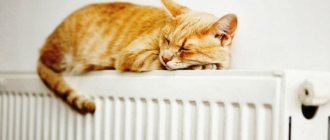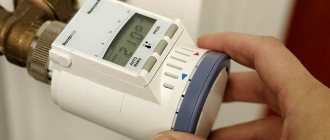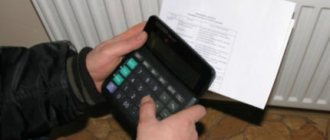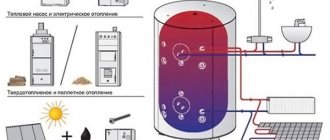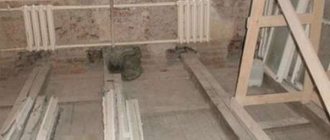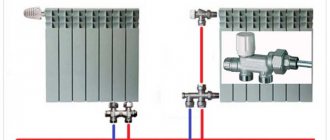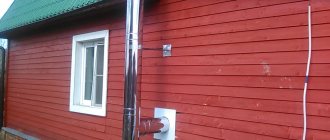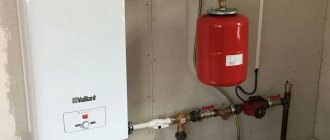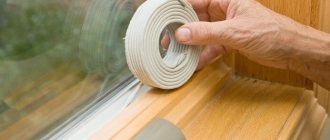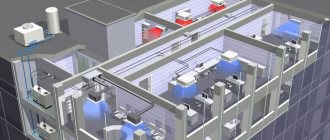Do you know why every September you are forced to freeze in your own apartment, waiting like manna from heaven for the central heating to turn on? The fact is that in Russia there are standards according to which heating can be started only after the average daily temperature for five days in a row does not exceed 8 degrees above zero.
In theory, during this time, apartment buildings should not yet have time to cool down to a critical temperature. By the way, it is 18 degrees above zero. The thermometer may drop lower - but no more than three degrees. Only when the temperature in your apartment drops below 15 degrees can utility workers have problems. For you, they can begin even earlier - many can get sick even at a temperature of 20 degrees, not to mention in a colder room.
Most often, tips for heating a room are relevant for the night, when the temperature in the apartment drops to the minimum values for the day, and we cannot actively spend time in order to warm up in this way. However, freezing in your own apartment at night because the central heating radiators are turned off is completely unnecessary. AiF.ru knows at least five ways to raise the temperature in the apartment so as not to contract the disease while waiting for the start of the heating season.
Air conditioner
To heat the apartment in the first way, we need an air conditioner. For some reason, many people forget that an air conditioner can perform not only its direct function - to cool the room, but also act in the completely opposite direction - to heat the air in the apartment.
In most models, it is enough to simply set the temperature with the control panel above the one you observe in the apartment at that moment. The air conditioner will automatically begin to circulate warm air around the room, warming it up. In some cases, you will have to look at the manual (if you saved it) or search for instructions for the air conditioner on the Internet - you will have to turn on the special heating function that should be in your device.
Article on the topic
The house is warm. How to choose a heater?
Window insulation
Poor quality or old windows are the main cause of heat loss in a private home. Through them you can lose up to 40% of heat, receiving drafts and cold in return. Therefore, it is with windows and their insulation that one should begin to eliminate heat loss in the house.
There are two ways to insulate windows:
- replacing old structures with new ones;
- repair of old window structures.
Replacing old windows with new ones
Today, PVC windows are very popular. They are distinguished by excellent heat and sound insulation, ease of maintenance, attractive appearance and affordable price. Manufacturers offer a large range of plastic structures that meet international requirements and standards. They are completely safe and reliable. Moreover, the service life of such PVC windows is at least 50 years.
No matter how warm old wooden window structures may seem, over time they dry out, forming cracks and allowing the cold to pass through. Therefore, it is appropriate to replace them with new warm windows.
However, it should be remembered that no matter how beautiful and modern the window is, first of all it must protect from the severe frosts and blizzards that await us in winter. Therefore, when insulating a house, the question arises about the correct choice of reliable and warm windows.
How to choose modern PVC windows, what to pay attention to and not to make mistakes, we advise you to learn from the video presented
These simple secrets will help you immediately make your home half warmer! Start insulating by replacing windows with modern, warm designs.
Repair of old window structures
This method is used in cases where it is not possible to replace old windows with new ones. The repair of structures should begin by sealing the places where the glass is connected to the frame.
Then we recommend paying attention to the gaps between the window opening and the frame. They also need to be caulked with foam rubber or cotton wool, covering the joints with strips of fabric or tape
To eliminate cracks, you can use foam or sealant. We should not forget about slopes and window sills: through the cracks in them you can unnoticed heat loss. Therefore, you will have to work on them too.
Electric heater
The most common way to warm up in a cold room with the central heating turned off is to turn on an electric heater.
The two most common types of electric heaters for us are the fan heater and the oil heater. The first one, however, is not suitable for night time: it is too noisy and not designed for long-term use. The second operates on the principle of a regular radiator, only it heats up not water, but special oil. It takes quite a long time to warm up the room, but modern oil heaters are completely safe to leave overnight.
Recently, humanity has invented several more types of electric heaters. The first of them is an electric convector: cold air, passing through a heating coil, heats up and exits from the top of the device. But such heaters also have disadvantages - they are quite bulky, like oil heaters, by the way, and relatively expensive.
The most modern heaters are infrared and carbon. They work on the same principle - a lamp emitting infrared rays heats people and objects without heating the air. But such a heater is also unlikely to be suitable for night vigils - a lamp, even an IR lamp, even a carbon one, emits a fairly strong glow and will interfere with falling asleep.
Rescue from the cold: causes of heat leaks and ways to eliminate them
More details
The best heat guns for a summer residence
Efficient heaters with a thermostat for cottages and homes are electric heat guns; their operating principle is fast and intense heating thanks to the heating element. While most conventional convectors provide a passive method of heat transfer, the guns in their design contain rotational elements, which ensure high operating efficiency. Experts analyzed popular models with good user responses on the Internet, tested them and named several leaders.
Wester TV-3/5
The first thing this electric gun can boast of is its compact size, so the design will not clutter up the room. The manufacturer recommends using it for small spaces, the maximum area of which will be 30 square meters. m. Power consumption is 3000 W, which is quite a high figure compared to its small size. In addition to the main function, Wester TV-3/5 provides air ventilation, which is important in hot weather. There is a handle-holder for easy movement, the body is protected from corrosion.
Advantages
- Emergency shutdown in case of overheating;
- Universal options;
- Safe design;
- Ability to work around the clock with a break of only 2 hours;
- Light weight and small dimensions;
- Steel body and frame;
- Low price.
Flaws
- Dries the air;
- Simple set of functions.
This is a simplified model for small spaces without innovation and modern technology. If the buyer needs a productive and fast heater at a low price, you can consider this option. It works in 3 modes - just ventilation, heating at half power, maximum heating.
The best electric fireplaces
Hyundai H-HG7-90-UI713
Another worthy electric heat gun is the Hyundai H-HG7-90-UI713 from a popular global brand. The heating element is responsible for the heating function; in addition, in the list of options you can see air ventilation, low and maximum heat transfer modes. The air supply is powerful, yet even and efficient. The performance indicator is overestimated in comparison with other competing models - 9000 W. The device can operate continuously for 22 hours, treating a fairly large space in the room.
Advantages
- High power;
- Stable uninterrupted operation;
- Convenient thermostat;
- Sturdy, reliable design;
- Quick installation;
- Safe operation.
Flaws
- There are not enough legs, it stands on the floor;
- Heavy weight.
In fact, the device is capable of serving rooms and buildings with an area of up to 60-80 square meters. m
The manufacturer guarantees a long service life even with continuous switching on; it is only important to take a break for a couple of hours every 22 hours
Timberk TIH Q2 6M
In the list of the best heat guns, a worthy place is occupied by the Swedish brand Timberk and the TIH Q2 6M model with a heating power of 6000 W. Users have dubbed the model industrial, since it is most often used at repair sites, workshops, and warehouses. Its main difference from its competitors is the stepwise power adjustment, which allows you to choose the optimal operating mode. Serviced area – 60 sq. m. High-quality manufacturing materials ensure durability and reliability of the assembly. The heating element is covered with a grille as protection.
Advantages
- Versatility – heating and air ventilation;
- Stability on legs;
- High performance;
- Protective shutdown in case of overheating;
- Long service life.
Flaws
- Dries the air;
- Mechanical control.
This model is recommended to be installed in rooms with high levels of dampness and moisture, since powerful blowing with warm air dries it effectively. Initially, the manufacturer focused on using the gun in large industrial warehouses.
Bathroom
The third way to raise the temperature in the apartment is very simple. To use it, you just need to open the doors to the bathroom. During the day, we would also advise you to take a hot bath, but at night its warmth will not be enough - the water will quickly cool down, giving up all the heat, and will become useless.
The point of open doors is that the temperature in the bathroom is a priori several degrees higher than throughout the apartment. This happens thanks to a hot water riser, which acts in the same way as a central heating radiator. But no one turns it off for the summer. The heated towel rail also plays an important role in heating the bathroom, as it also remains hot 365 days a year, 24 hours a day.
Of course, you won’t heat the entire apartment this way, but it is still possible to raise the overall temperature by 1-2 degrees using this method.
Article on the topic
Don't freeze! 10 ways to stay warm at home before you turn on the heating
Layered clothing
Clothes for a cold apartment should not just be warm, but multi-layered. Almost like streetwear: the bottom layer is for regulating body moisture, the top layer is for thermal insulation.
It is better to choose underwear from natural materials, for example, pure cotton. This could be a T-shirt or long sleeve. On top you can wear a sweatshirt, woolen sweater, hoodie, or even warm pajamas. It’s the same story with socks: first thin cotton ones and only then thick woolen ones.
Photo source: Piqsels
Electric heating pads
In the second half of September in the evening in your own unheated apartment, another electrical device will help you warm up - a heating pad. Typically, heating pads have a medical function and are used to warm up some part of the body that requires heat therapy. But they can also be used for purposes other than their intended purpose, if the situation forces it.
Most modern electric heating pads, which are available on pharmacy shelves, have a special temperature regulator. By setting it to the minimum value, you can create a completely comfortable atmosphere in your bed, which will allow you not to freeze on a September night.
Do not despair if even the minimum setting in the electric heating pad turns out to be too hot for you. The heating pad can be placed not in its traditional place under the sheet, but on top, on the blanket. In this case, it will give you less heat, which will partially escape into the atmosphere, and you will not experience overheating.
Article on the topic
Carpet and fan. 10 ways to make your apartment warmer
Protection from rodents during your absence
Whether your home is heated or unheated, mice and rats can enter your home. To avoid attracting undue attention from these pests, place all food supplies out of their reach. It should be taken into account that, having smelled something edible, for example, cereal, rats are able to gnaw even through a cabinet door. And having finished with food supplies, wires, wallpaper, bed linen and everything that can be chewed will be used. You should not use special poison, as it can later harm your pets or you. It’s better to clean up the mess and install an electronic repeller.
Carpets and crevices
It is worth noting that we ourselves, even at night while sleeping, produce a fairly large amount of heat. In order to heat a room exclusively on your own, it is necessary to minimize heat loss.
Primarily they occur due to the presence of cracks. If you do not have plastic windows, you will have to glue their perimeter with a special insulation, which will not allow cold air to penetrate into the apartment through the cracks, and warm air to seep out. The same applies to the front door - its perimeter should also be sealed with special insulation.
Cool surfaces also have a big impact on the temperature in the room. First of all, this concerns the floor and glass on the windows. To prevent the air in the entire room from being cooled by the window glass, it is better to curtain the windows at night with thick curtains that will cover almost the entire space from the eaves to the floor. This will allow some of the cool air to remain between the window and the curtains, preventing it from leaking into the rest of the room. All this is due to the low degree of thermal conductivity. Thanks to the same property of dense fabric, you can keep the heat in the room by covering the floor with any carpet.
Heating without fuel
Modern scientists have invented a way to heat a house even without burning any fuel resources - the so-called “heating without fuel”. This is achieved through the operation of a unique device – a heat pump.
Design and operation
The heat pump consists of tubes filled with freon, as well as several chambers - throttle, compressor, heat exchange. The operation of the device is similar to that of a refrigerator. It is called by scientists after its inventor the “Carnot cycle,” which is based on simple laws of physics:
- Liquid freon passes through tubes lowered deep into the ground or reservoir, where the temperature even in winter remains up to +8 0 C. There it becomes a gas, since its boiling point is only +3 0 C.
- Rising upward again, the freon gas enters the compressor chamber, where it is strongly compressed, which is quite easy to do with a gaseous substance. As is known, compression of any substance in a limited space leads to its heating, so freon heats up here to approximately 80 0 C.
- Transferring the resulting heat through the heat exchanger to the heating system, the freon passes to the throttle chamber, where its pressure and temperature decrease, turning it back into liquid.
- Next, the liquid freon is sent back to the depths of the earth to warm up, repeating the cycle again.
IMPORTANT! Of course, the heat pump still requires electricity to operate, but its amount is disproportionately less than with direct electrical heating of the coolant
Types of heat pumps
Heat pumps differ in the way the freon is heated before turning into gas, that is, in the source of “low-level heat”:
- Water for installation near ground-based reservoirs,
- Water to obtain heat from groundwater,
- Earthen,
- Airborne.
The name of the device also includes the type of coolant in your installed heating system, that is, the passport for it must contain the words: “soil-water”, “water-water”, “soil-air”, etc.
How to make your home warm
Issues of insulation of walls and ceilings are discussed in other blog articles:
Dew point, vapor barrier and ventilated gap.
Heating costs and heat transfer resistance.
Calculation of wall heat transfer resistance.
Calculation of the thickness of the insulation of the floor or attic.
Aerated concrete, gas silicate - what wall thickness to choose?
By the way, in this article you can find a table with GPS indicators for your region.
The wall is three-layer stone with brick cladding.
Insulation of the outside wall of a house with a ventilated facade.
Insulation of wooden houses, walls, log houses made of timber or logs.
Calculation of thermal insulation of a shallow foundation for a house.
From the article How to make a house warm. Breathability and ventilation
you can learn how to reduce heat loss with air flows passing through the house.
We will not repeat ourselves and will further consider other measures on how to make the house warm.
The influence of the shape of the house on heat loss
Obviously, the larger the area of enclosing structures (walls and attic floors) in the house, the greater the heat loss. The corners of external walls are additional cold bridges.
Therefore, a house with a compact square plan with four corners has the smallest area for heat transfer through the walls and ceilings. Moreover, such a house is cheaper to build.
In a house of equal area, but with a complex shaped plan (L-H-shaped, cross-shaped, etc.), heat loss through the walls and corners will increase. Calculations show that for a house with an area of 150 m2 in houses of complex shape, the need for heat will increase
all other things being equal, no more than 3.5%.
A complex house shape may be more visually attractive, but this will come at the cost of increased construction costs and annual fuel costs, or additional insulation.
It is advantageous to attach various unheated rooms to a house of a simple shape - a garage, a boiler room, a utility room, a winter garden on the garden side or a veranda at the entrance to the house. In winter, such rooms or even a covered terrace limit heat loss and protect the house from wind, and in summer - from overheating. Such rooms also increase the usable area of the house, which is important in the case of small buildings.
Buffer rooms must be separated from the heated part of the house by a wall with the same parameters as other external walls.
In addition, extensions can make the simple shape of a house more attractive, give it individual character and overcome the minimalism of the architectural form.
How does the need for heat depend on the number of storeys in the house?
Below is a table from SNiP, which indicates the specific heat energy consumption standards for houses of different sizes and number of floors. The standards are calculated taking into account the fact that all enclosing structures (walls, ceilings, floors, windows and doors) have a heat transfer resistance that meets the standards, and heat loss from the air escaping through the ventilation also meets the standards.
The table shows that as the number of floors increases, the heat consumption for heating the house also increases. For example, a two-story house with an area of 150 m2 requires 10% more heat than a one-story house.
A two-story house has a larger wall area and greater ventilation with outside air. A one-story house has a larger area of attic and basement floors, but these structures must also have a significantly greater standard resistance to heat transfer than walls.
As a result, a one-story house with the standard heat transfer resistance of the enclosing structures is 10% warmer than a two-story house.
The table shows the norms of specific heat energy consumption for heating , low-rise residential buildings, single-apartment detached and blocked (for the heating period), qh,req, kWh/m2:
| Heated area of the house, m2 | With number of floors | |||
| 1 | 2 | 3 | 4 | |
| 60 or less | 195 | — | — | — |
| 100 | 170 | 185 | — | — |
| 150 | 150 | 165 | 180 | — |
| 250 | 135 | 145 | 150 | 160 |
| 400 | — | 125 | 130 | 150 |
| 600 | — | 110 | 115 | 125 |
| 1000 or more | — | 95 | 105 | 110 |
Note. The required specific energy consumption is set based on the height of the premises of residential buildings - 3 m. For a specific project, it is allowed to recalculate the standard values presented in the table to others.
Building codes allow that the heat transfer resistance of individual house structures may be less than the standard , but provided that the specific heat energy consumption is not higher than that indicated in the table.
Let me remind you that the standard resistance to heat transfer of structures enclosing a house depends on the value of the GSOP at the construction site. A house built according to standards in any region must have a specific heat energy consumption no higher than that indicated in the table.
Using the table data, you can easily calculate the annual heat energy consumption for heating
your future home.
For example, for heating a one-story house
with an area of 150 m2, the following will be required annually: 150 m2 x 150 kWh/m2 = 22500 kWh.
If we use electricity for heating
, then, knowing the tariff (for example, 4.13 rubles/kWh), we find the heating costs per year: 22,500 kWh x 4.13 rubles/kWh = 92,295 rubles. We do not take into account losses during the conversion of electricity into heat due to their small value, which is acceptable for our calculations.
Under the same conditions, but for a two-story house,
the cost of electricity spent annually on heating the house will be 102,217.5 rubles. The developer can additionally insulate the house in order to ensure specific heat energy consumption, as for a one-story house.
Products for construction and repair
⇆
The cost of such additional measures should be determined by the payback period (for example, 12 years) and not exceed the amount: (RUB 102,217.5 – RUB 92,295) x 12 years = RUB 119,070. More expensive or less energy-saving measures will not be economically justified.
For other types of fuel, the calculation is more complicated and the final cost figures will naturally be different. For example, the calorific value of natural gas is 9.44 kWh/m3. The weighted average efficiency of a conventional (non-condensing) gas boiler is 82%.
For a one-story house from the previous example, gas consumption
during the heating period will be 22500 kWh/9.44 kWh/m3/0.82=2907 m3. Knowing the tariff for natural gas (for example, 5.14 rubles/m3), we find the cost of heating a one-story house per year with natural gas: 2907 m3 x 4.64 rubles/m3 = 14942 rubles.
The same, but for a two-story house
— 16434 rub. Cost-effective costs for additional energy-saving measures should not exceed the amount (16,434 rubles - 14,942 rubles) x 12 years = 17,908 rubles.
However, given the government’s policy of accelerating (faster than inflation) growth of energy tariffs, it is worth taking European fuel prices when making calculations
.
Brew warming teas
What does “warming” mean? “Any hot tea warms you,” you say. Yes, you can’t argue with that, but still, winter teas must contain special ingredients: ginger, cinnamon, lemon, honey, cloves, pepper. Here, for example, is a recipe for ginger tea with apple and lime:
- 0.5 l of water;
- 3–4 cm of ginger root;
- a pinch of cinnamon;
- 1 tsp. green tea;
- 3 tsp. flower honey;
- carnation;
- 1/2 lemon;
- green apple and lime slices.
- Peel and finely chop ginger root;
- pour water into a saucepan, add ginger, cinnamon, cloves;
- bring to a boil and cook for 10 minutes;
- put honey and lemon (squeeze the juice from the lemon and throw the rest into the saucepan);
- cook for another 5 minutes;
- Brew green tea in a teapot, strain the hot broth into it;
- Pour into mugs, adding green apple and lime slices. Ready!
